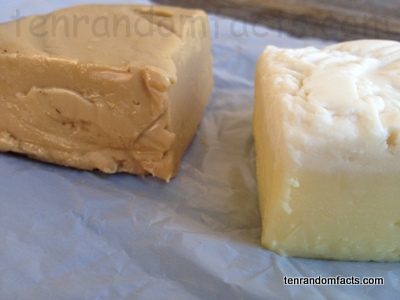Fudge! Well at least these facts aren’t messed up.
- Fudge is a sweet confectionery food item usually with a strong sweet flavour, that is usually eaten in small quantities.
- Fudge is typically made of sugar, butter and milk, and sometimes corn syrup, which slows the crystallisation process, and sometimes chocolate, for flavour.
- Fudge comes in a variety of colours, often coinciding with the various flavours available, and it may contain fruit or nuts.
- Fudge is typically made by heating the ingredients to temperatures of up to 116°C (240°F) and allowing it to partially cool; then beating the mixture until creamy and smooth and pouring it in a pan to set, before cutting.
- Although fudge traditionally has a smooth and creamy texture, it will become brittle or hard if cooked at higher temperatures.
- Fudge can be difficult to master as incorrect crystal sizes, due to imprecise cooking times; temperatures; or cooling processes; can cause more liquid or very hard solid versions of the confectionery.
- The origin of fudge is uncertain, however it is likely a North America invention, possibly prior to 1886; and the first known instance of commercialisation of the product is said to be in 1886 (sold for 40 cents per pound), in Baltimore in the state of Maryland, in the United States.
- The term ‘fudge’ possibly originated from the expression of annoyance typically used when something goes wrong, in this case, when making a confectionery that turned into a different substance than expected.
- Fudge is not very nutritious as it mostly contains large volumes of sugar and a significant portion of fat, although it has a small quantity of manganese and other vitamins and minerals.
- Fudge is commonly presented and sold in the shape of a rectangular block, and is usually available at market stalls or specialty confectionery stores.
Bibliography:
Fudge, 2014, Wikipedia, http://en.wikipedia.org/wiki/Fudge
The Science of Fudge, 2011, The Big Bake Theory, http://bigbaketheory.com/2011/12/22/the-science-of-fudge/
What is the History of Fudge?, 2014, WiseGEEK, http://www.wisegeek.com/what-is-the-history-of-fudge.htm








helped a lot!!!!! THANK U
thanksssssssssssssssssssssssssssssssssssssssssssssssssssssssssssssssss